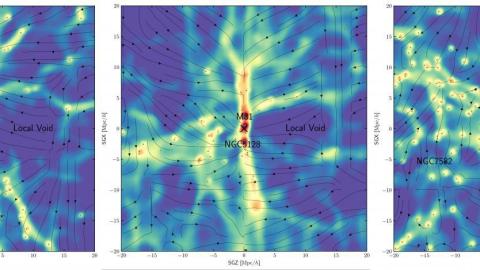Scientists find dark matter “bridges” that may reveal future of our galaxy

CREDIT: Hong et. al., Astrophysical Journal.
- Scientists use artificial intelligence to produce a new map of dark matter in the local universe.
- The map’s precision may lead to new insights into dark matter and the future of our universe.
- The map contains previously unknown “hidden bridges” that link galaxies.
A new map derived with the help of artificial intelligence reveals previously unknown “bridges” linking galaxies in the local universe. The bridges are in the form of filamentary structures. The scientists hope their map, published along with their paper in theAstrophysical Journal, can provide fresh insights into dark matter and the history of our universe.
While dark matter is an accepted notion, thought to make up 80 percent of all the matter in the universe, it has been hard to find. Scientists have, however, inferred much about the existence and behavior of dark matter by observing its gravitational influence on other space objects.
The universe has a dark matter skeleton
Cosmologists believe that dark matter serves as the filamentary skeleton of the cosmic web, which in turn, makes up the large-scale structure of the universe that partially controls the motion of galaxies and other cosmic systems.
While it’s not proven possible yet to directly measure how dark matter is distributed in our local universe, the international team behind the research used AI to create a new map. The “local universe,” which includes us, is an area about 1 billion light-years in radius where galaxies and related space objects are “essentially frozen in their present day configurations” and cosmic evolution effects are negligible, the astronomers explain.
“Ironically, it’s easier to study the distribution of dark matter much further away because it reflects the very distant past, which is much less complex,” said one of the study’s authors, Donghui Jeong, associate professor of astronomy and astrophysics at Penn State. “Over time, as the large-scale structure of the universe has grown, the complexity of the universe has increased, so it is inherently harder to make measurements about dark matter locally.”

A map of dark matter within the local universe. Smaller filamentary features (yellow) act as hidden bridges between galaxies. Dark matter’s gravitational influence on galaxies is indicated by black dots. Prominent features of the universe are shown by red dots and X marks the Milky Way.
CREDIT: Hong et. al., Astrophysical Journal.Creating a better dark matter map
Cosmic web maps created previously relied on simulating the 13.8-billion-year evolution of the universe from early stages to present day. Such efforts required a tremendous amount of computation and did not yet produce accurate representations of the local universe, leading researchers to devise a novel approach. For the new map, they focused on utilizing machine learning to create a model based on the distribution and motion of galaxies. This allowed them to estimate how dark matter is distributed.
The AI was trained on simulated galaxies similar to the Milky Way using Illustris-TNG — an ongoing series of simulations that features galaxies, dark matter, gasses, and other matter.
Jeong explained that if you feed specific information into the model, it can fill out the gaps, relying on what it has already processed. The scientists further confirmed the mapping by applying it to real local galaxy data from the Cosmicflows-3 catalog of distance information about nearly 18 thousand galaxies.
Hidden bridges
The resulting map features major structures in our local universe like the “local sheet,” which contains the Milky Way. Nearby galaxies and the “local void” — a nearby region of empty space — are also represented. What’s more, the map allowed researchers to spot new structures. In particular, they hope to study in greater depth the small filamentary structures they discovered that appear to link galaxies. Jeong called them “hidden bridges.”
Jeong believes these filaments can provide insight into the future of our galaxy. One particular question of note is whether the Milky Way would eventually collide with the Andromeda galaxy.
“Because dark matter dominates the dynamics of the universe, it basically determines our fate,” shared Jeong. “So we can ask a computer to evolve the map for billions of years to see what will happen in the local universe. And we can evolve the model back in time to understand the history of our cosmic neighborhood.”
Further studies that include galaxy data from new astronomical surveys will be needed to perfect the map’s accuracy.





